Reference no: EM13815291
Unless stated otherwise, in the following problems assume that games considered are games of repeated Prisoner's Dilemma with stage payoffs of 0, 1, 3 and 5, that is
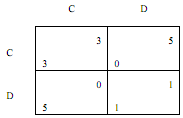
Problem 1:
Consider the following strategy "Tit for Two Tats" (TF2T): Cooperate in periods 1 and 2. Thereafter defect in any period k>2 if and only if your opponent defected in k-1 and k-2.
(a) Consider best response strategies to TF2T in a discounted repeated game with δ sufficiently close to zero.
Is it possible to construct two strategies, j and j*, such that both of them are best responses to TF2T and (TF2T, j) is in Nash equilibrium while (TF2T, j*) is not?
YES NO (circle one)
If your answer is YES then give an example of two strategies like that. Whenever possible use the strategies defined in the lecture notes, otherwise define a strategy of your own.
j = .................
j* = .................
(b) Consider best response strategies to TF2T in a discounted repeated game with δ sufficiently close to one.
Is it possible to construct two strategies, j and j*, such that both of them are best responses to TF2T and (TF2T, j) is in Nash equilibrium while (TF2T, j*) is not? YES NO (circle one)
If your answer is YES then give an example of two strategies like that. Whenever possible use the strategies defined in the lecture notes, otherwise define a strategy of your own.
j = .................
j* = .................
(c) Consider best response strategies to TF2T in a repeated game without discounting (the payoff is an average per period payoff.)
Is it possible to construct two strategies, j and j*, such that both of them are best responses to TF2T and (TF2T, j) is in Nash equilibrium while (TF2T, j*) is not?
YES NO (circle one)
If your answer is YES then give an example of two strategies like that. Whenever possible use the strategies defined in the lecture notes, otherwise define a strategy of your own.
j = .................
j* = .................
Problem 2
Recall the strategy "Virgin" (V): V defects unconditionally in the first ten periods and then from period eleven on V cooperates unconditionally if and only if the opponent cooperated in all ten initial periods, and defects unconditionally otherwise.
(a) Consider best response strategies to V in a discounted repeated game with δ sufficiently close to zero.
Is it possible to construct two strategies, j and j*, such that both of them are best responses to V and (V, j) is in Nash equilibrium while (V, j*) is not?
YES NO (circle one)
If your answer is YES then give an example of two strategies like that. Whenever possible use the strategies defined in the lecture notes, otherwise define a strategy of your own.
j = .................
j* = .................
(b) Consider best response strategies to V in a discounted repeated game with δ sufficiently close to one.
Is it possible to construct two strategies, j and j*, such that both of them are best responses to V and (V, j) is in Nash equilibrium while (V, j*) is not?
YES NO (circle one)
If your answer is YES then give an example of two strategies like that. Whenever possible use the strategies defined in the lecture notes, otherwise define a strategy of your own.
j = .................
j* = .................
(c) Consider best response strategies to V in a repeated game without discounting (the payoff is an average per period payoff.)
Is it possible to construct two strategies, j and j*, such that both of them are best responses to V and (V, j) is in Nash equilibrium while (V, j*) is not?
YES NO (circle one)
If your answer is YES then give an example of two strategies like that. Whenever possible use the strategies defined in the lecture notes, otherwise define a strategy of your own.
j = .................
j* = .................
Problem 3
Recall the strategy "Casanova" (CA): C cooperates unconditionally in the first fifteen periods and then from period sixteen on it defects unconditionally.
(a) Consider best response strategies to CA in a discounted repeated game with δ sufficiently close to zero.
Is it possible to construct two strategies, j and j*, such that both of them are best responses to CA and (CA, j) is in Nash equilibrium while (CA, j*) is not?
YES NO (circle one)
If your answer is YES then give an example of two strategies like that. Whenever possible use the strategies defined in the lecture notes, otherwise define a strategy of your own.
j = .................
j* = .................
(b) Consider best response strategies to CA in a discounted repeated game with δ sufficiently close to one.
Is it possible to construct two strategies, j and j*, such that both of them are best responses to CA and (CA, j) is in Nash equilibrium while (CA, j*) is not?
YES NO (circle one)
If your answer is YES then give an example of two strategies like that. Whenever possible use the strategies defined in the lecture notes, otherwise define a strategy of your own.
j = .................
j* = .................
(c) Consider best response strategies to CA in a repeated game without discounting (the payoff is an average per period payoff.)
Is it possible to construct two strategies, j and j*, such that both of them are best responses to CA and (CA, j) is in Nash equilibrium while (CA, j*) is not?
YES NO (circle one)
If your answer is YES then give an example of two strategies like that. Whenever possible use the strategies defined in the lecture notes, otherwise define a strategy of your own.
j = .................
j* = .................
Problem 4
In the following problem assume that the game is that of infinitely repeated Prisoner's Dilemma with one-shot payoffs of 0, 1, 3 and 5 and without discounting (payoffs are calculated as per- period average.)
BR below stands for Best Response.
Are the following statements true of false? Circle the correct answer.
(1) If a pair of strategies (i,j) is such that i=BR(j) then u(i,j) ≥ 3. TRUE FALSE
(2) If a pair of strategies (i,j) is such that j=BR(i) then u(i,j) ≥ 3. TRUE FALSE
(3) If a pair of strategies (i,j) is such that i=BR(j) then u(i,j) ≥ 1. TRUE FALSE
(4) If a pair of strategies (i,j) is such that j=BR(i) then u(i,j) ≥ 1. TRUE FALSE
(5) If a pair of strategies (i,j) is such that i=BR(j) then u(i,j) < 5. TRUE FALSE
(6) If a pair of strategies (i,j) is such that j=BR(i) then u(i,j) < 5. TRUE FALSE
(7) If a pair of strategies (i,j) is in Nash equilibrium then u(i,j) ≥ 3. TRUE FALSE
(8) If a pair of strategies (i,j) is in Nash equilibrium and u(i,j)>3 then u(j,i)<3. TRUE FALSE
(9) If a pair of strategies (i,j) is in Nash equilibrium and u(i,j)<3 then u(j,i)>3. TRUE FALSE
(10) If a pair of strategies (i,j) is in Nash equilibrium then u(i,j) ≥ 1. TRUE FALSE
(11) If a pair of strategies (i,j) is in Nash equilibrium then u(i,j) ≤ 3. TRUE FALSE
(12) If a pair of strategies (i,j) is in Nash equilibrium then u(i,j) < 5. TRUE FALSE
Consider now the following strategies in an infinitely repeated Prisoner's Dilemma game: ALL D: defect unconditionally in all iterations of the game; ALL C: cooperate unconditionally in all iterations of the game; TFT (tit for tat): cooperate in the first interaction and then cooperate if the other player cooperated on the previous interaction and defect if he defected; STFT (suspicious tit for tat): defect in the first interaction and then cooperate if the other player cooperated on the previous interaction and defect if he defected; MACHO defect in the first iteration; in second iteration cooperate if the other player defected in the first iteration and then play "tit for tat"; if he cooperated in the first iteration, defect unconditionally in all periods of the game from iteration 2 onwards.
Problem 5
Consider an infinitely repeated Prisoner's Dilemma game with values of δ sufficiently close to (but not equal to) 0. Which of the following are true?
(1) ALL D is a best response strategy to TFT TRUE FALSE
(2) MACHO is a best response strategy to MACHO TRUE FALSE
(3) TFT is a best response strategy to TFT TRUE FALSE
(4) ALL D is a best response strategy to MACHO TRUE FALSE
(5) ALL D is a best response strategy to ALL C TRUE FALSE
(6) ALL C is a best response strategy to TFT TRUE FALSE
(7) STFT is a best response strategy to ALL D TRUE FALSE
(8) STFT is a best response strategy to STFT TRUE FALSE
Consider now an infinitely repeated Prisoner's Dilemma game with values of δ sufficiently close to 1. Which of the following are true?
(9) ALL D is a best response strategy to TFT TRUE FALSE
(10) MACHO is a best response strategy to MACHO TRUE FALSE
(11) TFT is a best response strategy to TFT TRUE FALSE
(12) ALL D is a best response strategy to MACHO TRUE FALSE
(13) ALL D is a best response strategy to ALL C TRUE FALSE
(14) ALL C is a best response strategy to TFT TRUE FALSE
(15) STFT is a best response strategy to ALL D TRUE FALSE
(16) STFT is a best response strategy to STFT TRUE FALSE
Problem 6
Which of the following pairs of strategies are in Nash equilibrium in the repeated Prisoner's Dilemma game without discounting? Circle YES if a pair is in Nash equilibrium and NO otherwise.
(MACHO, MACHO) YES NO
(TFT, STFT) YES NO
(ALL D, ALL D) YES NO
(TFT, TFT) YES NO
Problem 7
The game below is similar to the game of Chicken (aka Hawk and Dove.) Suppose it is a stage game of an infinitely repeated game without discounting (the payoff is an average per period payoff.)
Using the coordinate system below draw a "folk theorem diagram" i.e., a diagram that shows which pairs of payoffs are possible in the game and which pairs of payoffs are possible in Nash equilibria of this game. Mark all necessary numerical values in the coordinate system.
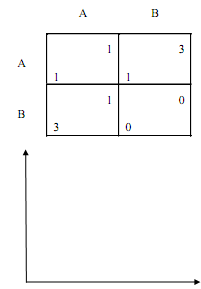
Problem 8
The game below is similar to that of Prisoner's Dilemma. Suppose it is a stage game of an infinitely repeated game without discounting (the payoff is an average per period payoff.)
Using the coordinate system below draw a "folk theorem diagram" i.e., a diagram that shows which pairs of payoffs are possible in the game and which pairs of payoffs are possible in Nash equilibria of this game. Mark all necessary numerical values in the coordinate system.
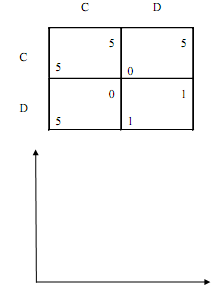
Problem 9
The game below is similar to the Pareto Coordination game. Suppose it is a stage game of an infinitely repeated game without discounting (the payoff is an average per period payoff.)
Using the coordinate system below draw a "folk theorem diagram" i.e., a diagram that shows which pairs of payoffs are possible in the game and which pairs of payoffs are possible in Nash equilibria of this game. Mark all necessary numerical values in the coordinate system.
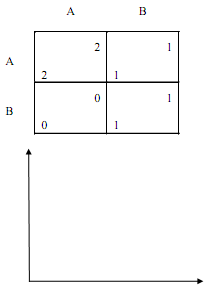
Problem 10
(1) Consider the following game.
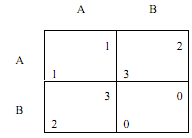
Suppose that what evolves in an evolutionary game are strategies (both pure and mixed) in a one- shot game depicted above.
Is pure strategy A an ESS? (Circle one.) YES NO
Is pure strategy B an ESS? (Circle one.) YES NO
(2) Consider the following coordination game:
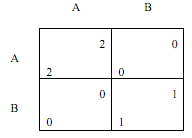
Suppose that what evolves in an evolutionary game are strategies (both pure and mixed) in a one- shot game depicted above.
Is pure strategy A an ESS? (Circle one.) YES NO
Is pure strategy B an ESS? (Circle one.) YES NO
(3) Consider the following Chicken aka Hawk-Dove game (strategies denote choosing "aggress" (B) or "not aggress" (A)):
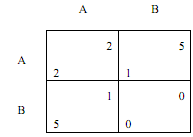
Suppose that what evolves in an evolutionary game are strategies (both pure and mixed) in a one- shot game depicted above.
Is pure strategy A an ESS? (Circle one.) YES NO
Is pure strategy B an ESS? (Circle one.) YES NO
Problem 11
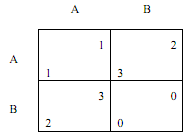
Consider now an evolutionary game where what evolves are not strategies in a one-shot game but strategies in a repeated game without discounting. The stage game of the repeated game is given above. Consider only pure strategies in this repeated game. (WESS stands for weak ESS.)
(a) Is strategy ALL A ("play A unconditionally in all iterations of the game") an WESS? (Circle one.) YES NO
(b) Is strategy ALL B ("play B unconditionally in all iterations of the game") an WESS? (Circle one.) YES NO
(c) Is strategy RECIPROCATE ("play A in period 1 and then play what the other player played in the previous period") an WESS? (Circle one.) YES NO
Problem 12
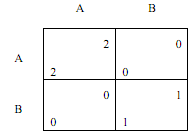
(a) Is strategy ALL A ("play A unconditionally in all iterations of the game") an WESS? (Circle one.) YES NO
(b) Is strategy ALL B ("play B unconditionally in all iterations of the game") an WESS? (Circle one.) YES NO
(c) Is strategy RECIPROCATE ("play A in period 1 and then play what the other player played in the previous period") an WESS? (Circle one.) YES NO
In the problems below assume that the evolutionary games involve an infinitely repeated Prisoner's Dilemma with one-shot payoffs of 0, 1, 3 and 5 and without discounting (payoffs are calculated as per-period average.)
Problem 13
Consider now the following strategies in an infinitely repeated Prisoner's Dilemma game: ALL D: defect unconditionally in all iterations of the game; STFT (suspicious tit for tat): defect in the first interaction and then cooperate if the other player cooperated on the previous interaction and defect if he defected; MACHO: defect in the first iteration; in second iteration cooperate if the other player defected in the first iteration and then play "tit for tat"; if he cooperated in the first iteration, defect unconditionally in all periods of the game from iteration 2 onwards; TF2T (tit for two tats): cooperate in periods 1 and 2. Thereafter defect in any period k>2 if and only if your opponent defected in k-1 and k-2.
Which strategies from the set above are weak ESS (WESS)? List all strategies that are weak WESS:
Problem 14
What is the relationship between Nash equilibrium and WESS? More specifically,
1. Can you find a strategy s such that (s, s) is in Nash equilibrium and s is not WESS? (Circle one.) YES NO
2. Can you find a strategy s which is WESS and (s, s) is not a Nash equilibrium? (Circle one.) YES NO
Problem 15
Can you find a strategy s such that u(s, s) = 3, (s, s) is in Nash equilibrium, and s is not WESS? Prove your claim.